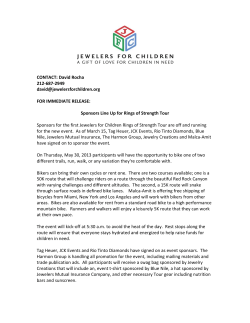
Jewelry Industry: Tiffany & Co. Group 6 John Cayo
Jewelry Industry: Tiffany & Co. Group 6 John Cayo Jessica Wilson Kirk Griffith Jessica Aragon Brandy Wolfe Raynee Bradley Cole Naylor The Jewelry Industry • Jewelry dates back to 75,000 years ago • Uses of jewelry: wealth, status, membership, etc. • The industry is timeless and very attractive to those who are in it Main Players of the Industry: • • • • • • Tiffany & Co. (top competitor) Blue Nile Inc. Signet Jewelers Limited Zale Corporation DGSE Companies Inc. Birks and Mayors Inc. Industry Life Cycle • Mature stage • Will not be taken down by economic crisis – Adaptation: Short-run & Medium-run • Research shows that this is a favorable industry Overview of the Environmental Scan There are six environmental factors that an investor needs consider when analyzing an industry: economic, political, social, technological, competitive, and geographical. These factors are known as the environmental scan. Performing this secondary research provides an investor with much needed insight into an industry and helps build a foundation for further exploration and analysis. The 6 Environmental Factors • • • • • • Economic Political Social Technological Competitive Geographical Additional Implications • Dependence on Economic Well-Being • Reliance on Suppliers and Natural Resources • Market Niches Dependence on Economic WellBeing Annual Revenues ($ millions) Industry Revenue Totals (annual) 12,000 10,000 8,000 6,000 4,000 2,000 0 1 2 3 4 5 Year begginning in 2004 X-Axis: 1,2,3,4,5 refer to Year 2004, 2005, 2006, 2007, 2008 respectively Dependence on Economic WellBeing Industry Revenue Growth % of industry growth 2.00% 0.00% -2.00% 1 2 3 4 5 -4.00% -6.00% -8.00% -10.00% -12.00% -14.00% Year Begginning in 2004 -Axis: 1,2,3,4,5 refer to Year 2004, 2005, 2006, 2007, 2008 respectively. Driving Forces for Change • In the last couple of years politics and economics have played a big role in driving companies in the jewelry industry to change in order to stay competitive. Conflict Diamonds • Conflict diamonds better known as “Blood diamonds” • Used to fund conflicts in war-torn areas. • Captured the world’s attention in 1990’s, but more recently in the movie “Blood Diamond” • Conflict diamonds represent 4% of the world’s diamond supply Changes Made • In January 2003, an intergovernmental agreement was created called the Kimberley Process Certification Scheme was created. • Companies also participate in a voluntary program of self-regulation in addition to KPCS. • Eliminates conflict diamonds from the world’s diamond supply. • Through these joint efforts 99% of the world’s diamond supply is free from conflict diamonds. Dirty Gold Mining • Gold mining has been a dirty practice for over 4500 years. • Conditions worsen as easily accessible deposits of gold have declined, and open-pit mining is becoming more wide spread. • These practices lead to destruction of the environment, damage to the ecosystem, and the opening of vast craters. Social Responsibility • In 2003 Tiffany and Co. ~ “framework for responsible mining: A guide to evolve standards.” • Zale Corporation, along with other industry members, formed the not-for-profit Council for Responsible Jewelry Practices in May 2005 • Since this move began, more and more companies seem to be making the change to this more socially responsible initiative. • Since repeat consumers play a key role in the success of the jewelry industry it is important for companies to adapt to the evolving mindset of their consumers which in this case is to take a strong position in social and ethical responsibility. The Current Economic Condition • Jewelry companies across the board take a second look at their strategies in attempt to weather this current economic storm. • The jewelry industry, which typically gets most of its profits from Valentine’s Day, Christmas, and Mother’s Day, has also seen a downturn in the recent years due to the current economic situation. • Companies are approaching this situation in a number of ways. Marketing Techniques • Companies are using ads to adapt to the current mindset of its consumers. • Jewelry is considered a luxury and not a necessity • Some companies are changing their approach to make diamonds seem like a “thoughtful investment” rather than a luxury. De Beers • "Here Today. Here Tomorrow. In times like these, it's perhaps wise to reflect on the things that last rather than the things that come and go. A diamond has outlasted all that history can throw at it, from the formation of continents to the turmoil of markets. Across the generations, in a thousand years' time, a diamond will still be here. Just like love. Just not like your 401(k).” Other Marketing Techniques • High-end retailers have chosen to focus on upper-class consumers. • These consumers are less likely to be as affected by the current economic state. • They continue to use quality as their competitive advantage. Tiffany and Co. • "Dreams Can Still Come True, Give her the ring of her dreams. For less than you imagine, the best there is." • This ad still focuses on the high quality that Tiffany and Co. is known for, yet it changes its approach by saying “dreams can still come true” implying that even in this down-turned economy you can get great quality for the one you love. “Good to Great” • The strategy that De Beers and Tiffany and Co. have chosen to follow is similar to the mindset of the Stockdale Paradox. • It talks about facing the brutal facts of your current reality. • The companies are embracing this crisis and adapting their strategy to sustain their market positions in the changing environment. Facing even more Brutal Facts • As the economy has continued to decline these marketing techniques have become less successful. • “Aspirational buyers” have been knocked out of the highend jewelry market. • Even companies such as Tiffany and Co. have even seen a decline in recent sales. • The few companies that do continue to market to just upper class successfully are usually the retailers that have higher brand recognition and greater differentiation of products- Providing greater customer loyalty. Innovative Designers • Innovative designers are very important. • Companies do not typically brand their products. • Innovative designers provide companies with a recognizable product design and packing. • They also give companies a wider range of products. • This helps them differentiate from their competitors while battling in the red ocean of the jewelry industry. Market Niches • “The Right-Hand-Ring”-De Beers, Helzberg, Zale Corp. and others. • Men’s Jewelry • Estate Jewelry • Gay Americans - a segment that has been steadily growing as civil marriages are becoming more prevalent. Inflation • Raw materials such as platinum and silver are at an all time high at an estimated 60 percent and 40 percent, respectively, from a year ago. • Companies have started to increase their prices to compensate for their costs due to inflation. • This causes an additional adverse impact on the demand for jewelry, especially for companies that compete on price, such as Wal-Mart. • High-end companies don’t seem to be as affected. • As of right now, it remains to be unseen what will exactly become of the jewelry industry as a whole as the economy continues to change. • Whether it is for the better or worse, these companies will persist in finding ways to remain competitive as there are always driving forces in this ever-changing economy. Porters Five Forces Competitive Rivalry amongst existing firms: HIGH •In the jewelry industry companies that are considered mass merchandisers or limited line jewelers generally compete on the basis of price. •Specialty jewelry companies, have found great success competing on quality rather than competing on price. Brand recognition is the greatest asset. •There is a high growth rate in the industry. As the jewelry industry expands globally, the industries top competitors are opening many stores in order to increase market share and capitalize on competition. •This has created a stagnant industry that now competes by taking market share away from the other players and creates price wars among many of the firms in the industry. • The switching costs and degrees of differentiation lower as the industry grows. These low degrees of differentiation lead to consumers purchasing items based on price rather than quality. Threat of New Entrants: Moderate to Low • Several of the existing firms have contracts with well-known diamond distributing companies. • New entrants may find it difficult to contract with these companies, because they lack the financial status. Also new entrants do not have a reputable name, which may cause doubt from a diamond distributing company and thus no contract will be created. • The entry into this market is getting increasingly difficult due to the growth of companies already established in the industry and due to high initial investment costs. • Existing firms experience economies of scale from large investments in research and development, brand advertising, or in physical location of stores. • The barriers to entry and to exit are very high in this industry. Threat of New Entrants (continued) •Large economies of scale make it very difficult for new entrants to compete in an industry. •The more assets a firm has the greater the firms ability to take advantage of economies of scale. •The following chart shows each of the competitors total assets from 2006 to 2008 Total Assets (in thousands) 2006 2007 2008 Tiffany & Co. 2,777,272 2,845,510 2,922,156 Blue Nile Inc. 138,005 122,106 160,586 Signet Jewelers 3,106,288 3,442,710 3,564,700 Zale Corp. 1,462,568 1,613,946 1,422,622 DGSE Inc. 11,830 13,146 36,859 Birks and Mayors 229,489 252,516 291,848 Threat of Substitute Products: High • The threat of substitutes depends on the relative price and performance of the competing products and on customers’ willingness to consider substitutes. • In this Industry there are millions of consumers who will not purchase a diamond unless they are absolutely certain it is conflict free due to ethical and social concerns. Since conflict free diamonds are harder and more expensive to obtain, this creates a high level of competition for the jewelry industry. • Products price elasticity is also affected by substitute products. For example, as more substitutes become available the demand becomes more elastic because customers have more alternative choices. Therefore a close substitute product constrains the ability of firms in the industry to raise prices. Bargaining Power of Customers: Moderate • When there is a large market of buyers the industry has the ability to set its price points as high or as low as they choose. • Customers have little bargaining power regarding price when they shop at luxury stores and refuse to search for alternatives, because of such a limited selection. • However, when buyer power is strong, “the relationship to the producing industry is near to what an economist terms a monopsony- a market in which there are many suppliers and one buyer.” (Quickmba) In this particular market condition, the buyer sets the price. Bargaining Power of Suppliers: High • Since diamonds are scarce, mining companies have absolute control over the selling price. • Diamond-mining companies such as DeBeers and Aber control the price of the diamonds that are supplied to several firms in the jewelry industry, such as Tiffany and Co. Since these precious gems are of great value to the firms, the power of the supplier is even larger. • The power of suppliers within the jewelry industry has skyrocketed within the last few years due to natural gemstone scarcity. Major Players • • • • • • Tiffany and Co. Blue Nile Inc. Signet Jewelers Limited Zale Corporation DGSE Companies Inc. Birks and Mayors Inc. Tiffany and Co. • TIF • Founded 1837 • Headquartered in New York, New York • Stores • Compete Blue Nile Inc. • • • • NILE Founded 1999 Online selling Compete Signet Jewelers Limited • SIG • Founded 1950 • Headquartered in London, United Kingdom • Store names and locations • Compete Zale Corporation • • • • • ZLC Founded 1989 Headquartered in Irving, Texas Store names and locations Compete DGSE Companies Inc. • • • • • DGC Founded 1965 Headquartered in Dallas, Texas Online auctions Compete Birks and Mayors Inc. • BMJ • Founded 1879 and headquartered in Montreal, Canada • Store names and locations • Compete Financial Data • • • • • • • • Current Ratio Debt/Equity Ratio Stock Price Market Cap Total Revenue Return on Equity Mean Recommendation Long Term Growth Rate Over 5 Years •How well assets cover short term obligations. •Companies ability to borrow and repay loans. Stock Price * *BMJ taken from November 05 because that is as far back as stock history could be found. Market Cap PRESE NT TIF NILE SIG 2.43B 307.54B 63.21M •Mid cap – TIF •Micro cap – NILE & SIG •Nano cap – ZLC DCG ZLC DCG BMJ 36.67M 9.05M 4.99M Total Revenue 2008 TIF NILE SIG ZLC 3.1B 295.3B 3.6B 2.1B •Sales must be brought in to turn a profit. Return on Equity •The higher the percentage, the more likely the company is able to generate cash internally. •Suggests if a stock should be bought or sold Long Term Growth Rate Over Five Years •This illustrates Who will grow the most and a profitable investment. Predicting the Moves That Competitors Will Make Trends • Developing socially responsible lines of jewelry • How competitors deal with economic crisis • Use of e-commerce in the industry Social Responsibility • Becoming a fashion trend • “Conflict Free” • Free of violence, war and exploitation • Jewelry for a cause • Bulgari & Pandora • Segmented target marketing • “Movie Bling” on Emitations.com Bulgari Pandora Dealing with Economic Crisis • Focusing on lower-priced pieces • ShopNBC.com • Luxury goods tax • New York • Buyouts • Berkshire Hathaway • Bankruptcy • Fortunoff Fine Jewelry E-commerce Innovations • Different approach to online purchasing • New niches • Harry Winston – lower priced pieces • Blue Nile – fashion jewelry • Uncertainty in these times, but potential for huge success in the future Predictions • Must lower prices to keep up in crisis • Target specific customers through direct marketing and new market niches via internet • Move toward “Conflict Free” lines • Partner with charity organizations • Enhance online shopping options Key Success Factors in the Jewelry Industry •Introduction and execution of e-commerce •Understanding and reacting to economic conditions •Aspects of consumer spending E-Commerce • History of e-commerce • Consumers new “power of choice” • Blue Nile Inc. reported a 30 percent growth from 2003 to 2004, showing a need for items to be offered not only in stores, but also online. Economic Conditions • Key players may face volatile prices, mergers, or even bankruptcy in the near future • A strong leadership team from the bottom up • Issue of divergence of demand • Apply resources where the opportunities for profits are the highest Understanding Consumer Spending – Disposable personal income variances – Prices of goods and services unstable – Issues in a struggling economy and overcoming: • Two types of jewelry consumers and the effect on high end vs. lower end jewelers • Being socially responsible • Continuously monitor the changing environment and adapt accordingly Conclusions - This is a favorable industry: - Can take advantage of market trends History proves that jewelry is long-lasting Highly volatile market, highly attractive Will overcome the economic crisis Always Remember… Diamonds are a girl’s best friend!
© Copyright 2025










